Sometimes a snake isn’t as dead as it seems to be (and that can scare the dickens out of a predator).
I’ve seen far more snakes in northern Utah this summer than I ever have in the past and it seems that Red-tailed Hawks are taking advantage of their bounty. But based on what I observed with this adult hawk two days ago it’s my guess that some of them don’t have much experience with snakes as prey.
- Note: These images are heavily cropped and the light was harsh so image quality isn’t the best but it’s good enough to document the behavior.
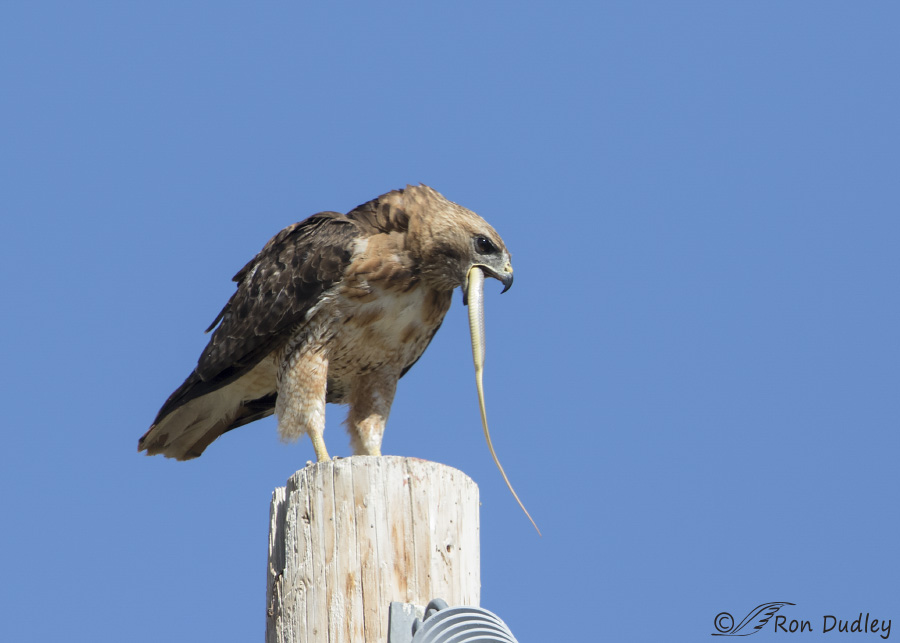
1/1000, f/7.1, ISO 320, Canon 7D Mark II, Canon EF 500mm f/4L IS II USM + 1.4 tc, not baited, set up or called in
By the time I was able to train my lens on this Red-tailed Hawk its snake prey was already headless and partially consumed – all that was left was the rear half (roughly) of the body of the snake. At this point the hawk attempted to swallow the rest of the snake in one giant slithering gulp but the snake wasn’t cooperating because it was still moving. Sometimes vigorously. Snakes are well-known for reflexive muscle movements long after they’re technically dead or have been decapitated.
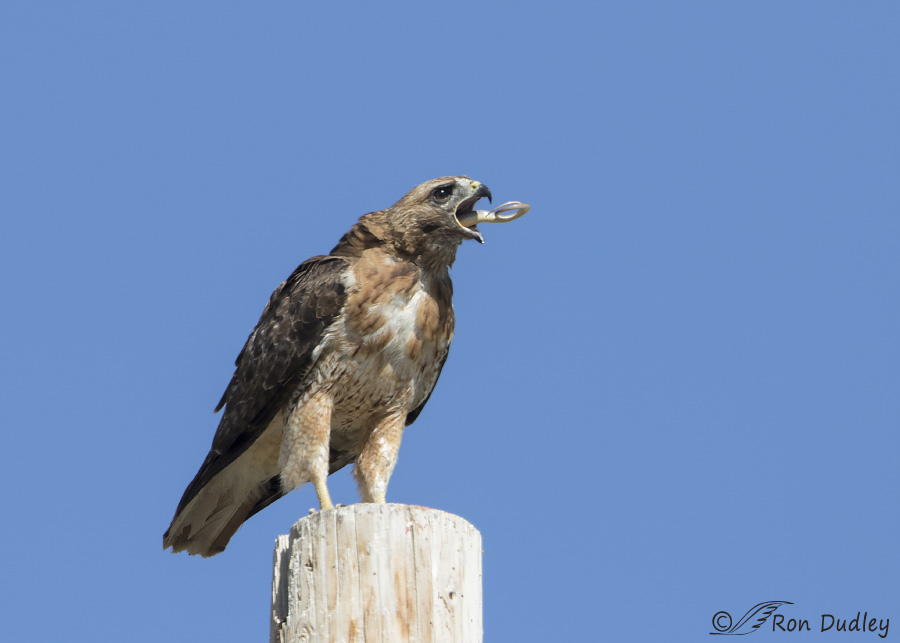
1/1000, f/7.1, ISO 320, Canon 7D Mark II, Canon EF 500mm f/4L IS II USM + 1.4 tc, not baited, set up or called in
Here we see the snake reflexively coiling its tail as the bird tries to swallow the last little bit.
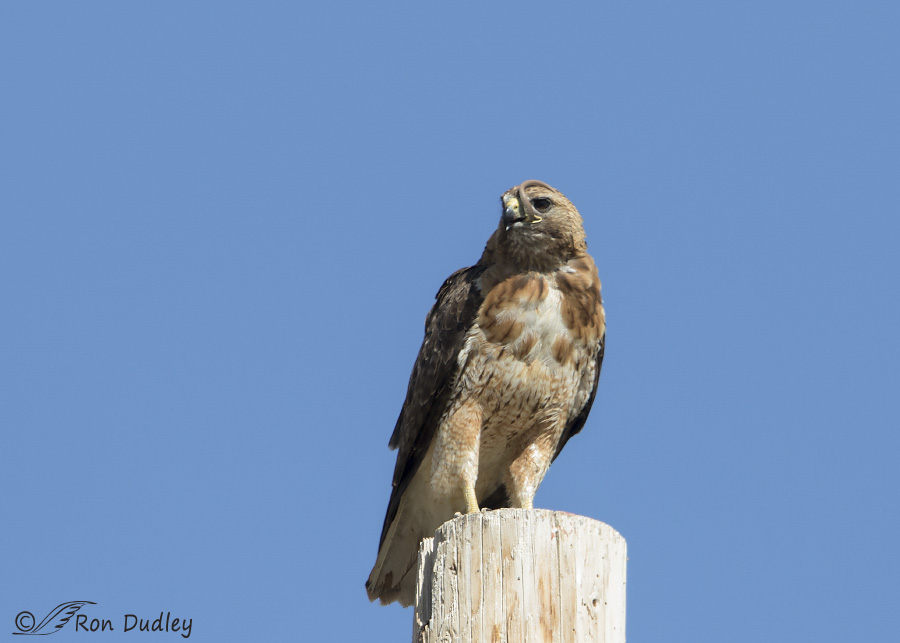
1/1000, f/7.1, ISO 320, Canon 7D Mark II, Canon EF 500mm f/4L IS II USM + 1.4 tc, not baited, set up or called in
This was as far down as the hawk could get the snake.
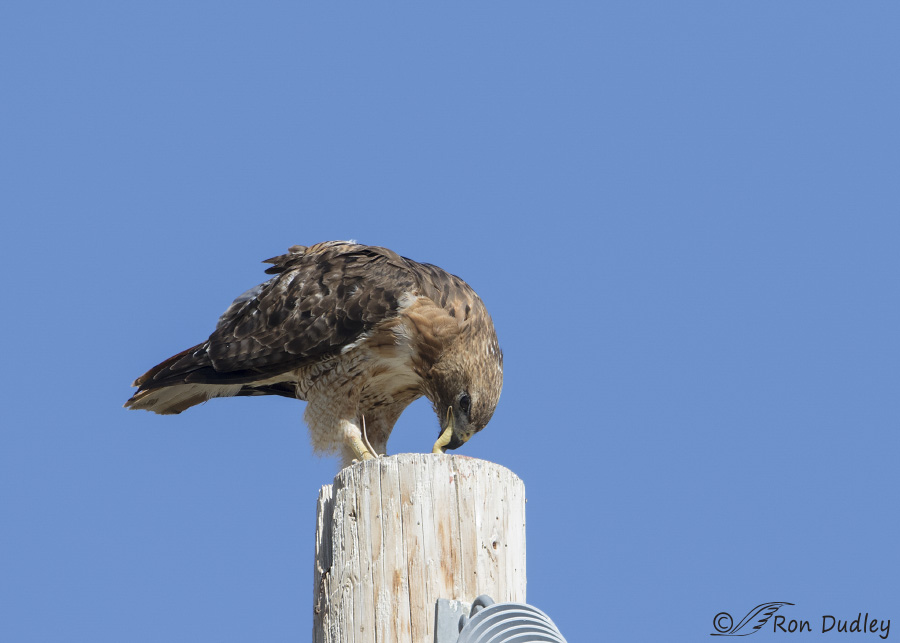
1/1000, f/7.1, ISO 320, Canon 7D Mark II, Canon EF 500mm f/4L IS II USM + 1.4 tc, not baited, set up or called in
So the bird gave up, stepped on the end of the tail with its right foot…
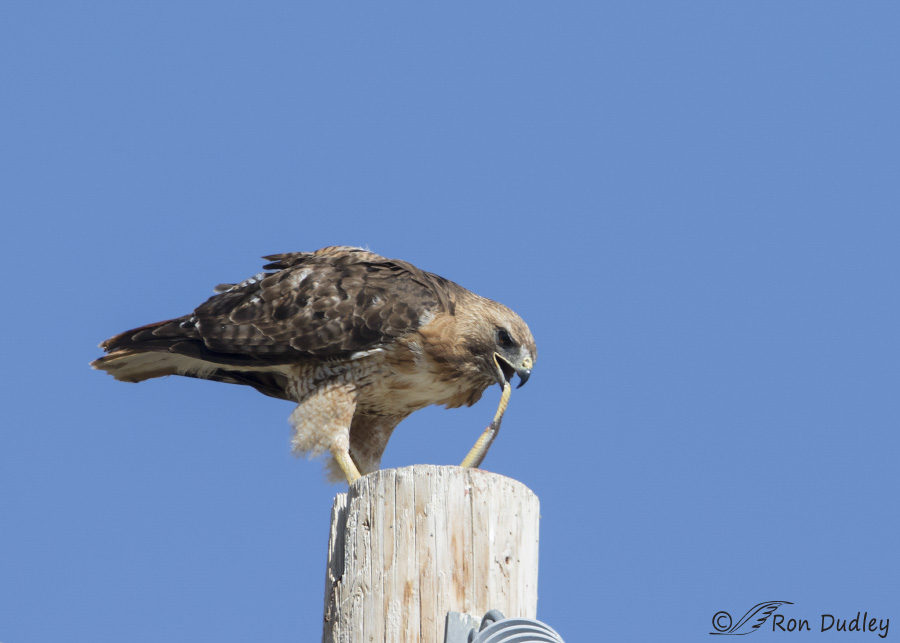
1/1000, f/7.1, ISO 320, Canon 7D Mark II, Canon EF 500mm f/4L IS II USM + 1.4 tc, not baited, set up or called in
and pulled that portion of the snake back out of its throat.
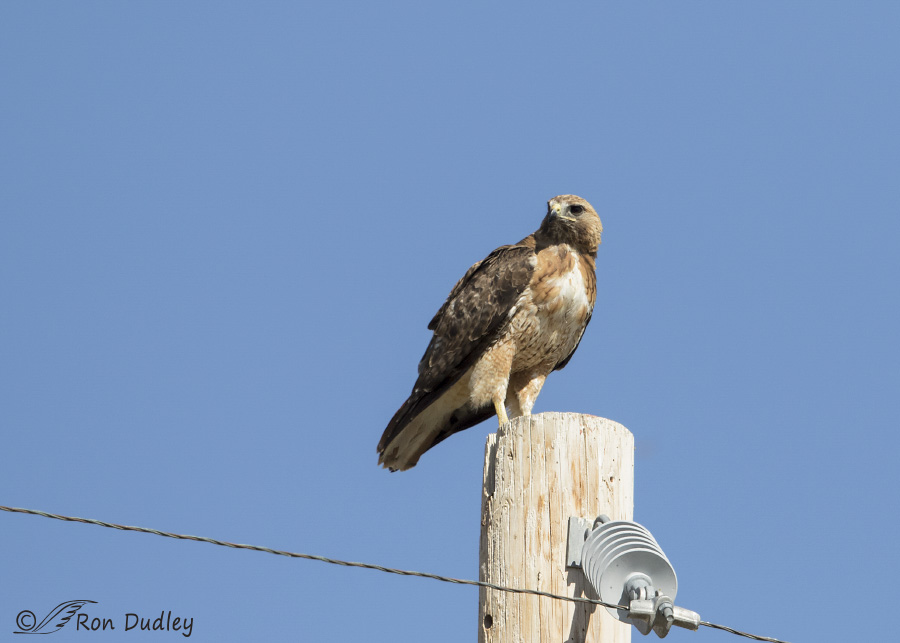
1/3200, f/7.1, ISO 400, Canon 7D Mark II, Canon EF 500mm f/4L IS II USM, not baited, set up or called in
At this point the hawk took a short rest to contemplate the situation (I had removed my teleconverter in anticipation of takeoff). The remains of the snake are on top of the pole where we can’t see them. I suspect the intention of the bird was to consume that part of the snake in bits and pieces but the snake apparently had other ideas.
I don’t know precisely what happened next because I couldn’t see the snake. But something unexpected certainly did happen because the hawk (from this resting position with no body posture indicating imminent takeoff) suddenly…
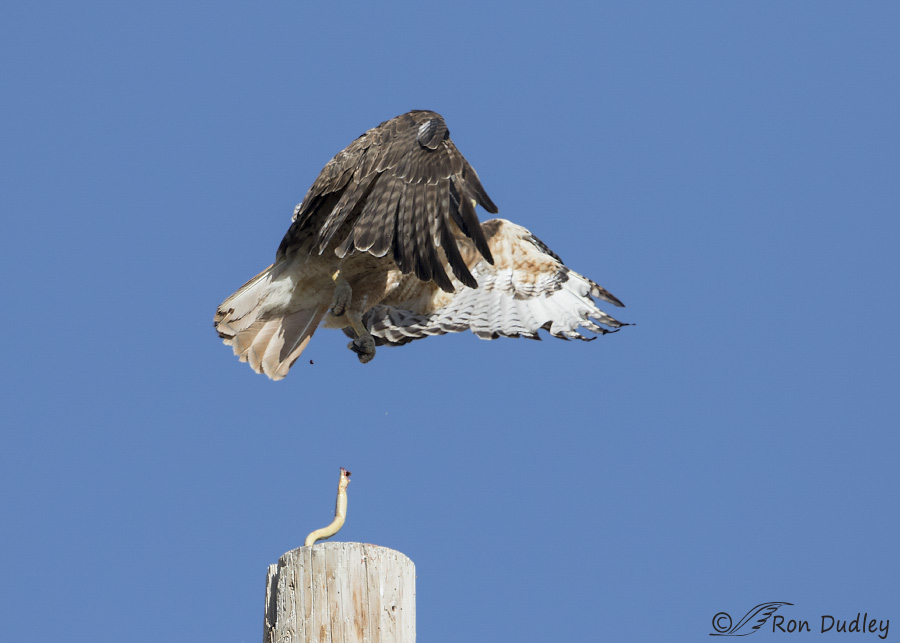
1/3200, f/7.1, ISO 400, Canon 7D Mark II, Canon EF 500mm f/4L IS II USM, not baited, set up or called in
leaped straight up into the air with the snake seeming to follow.
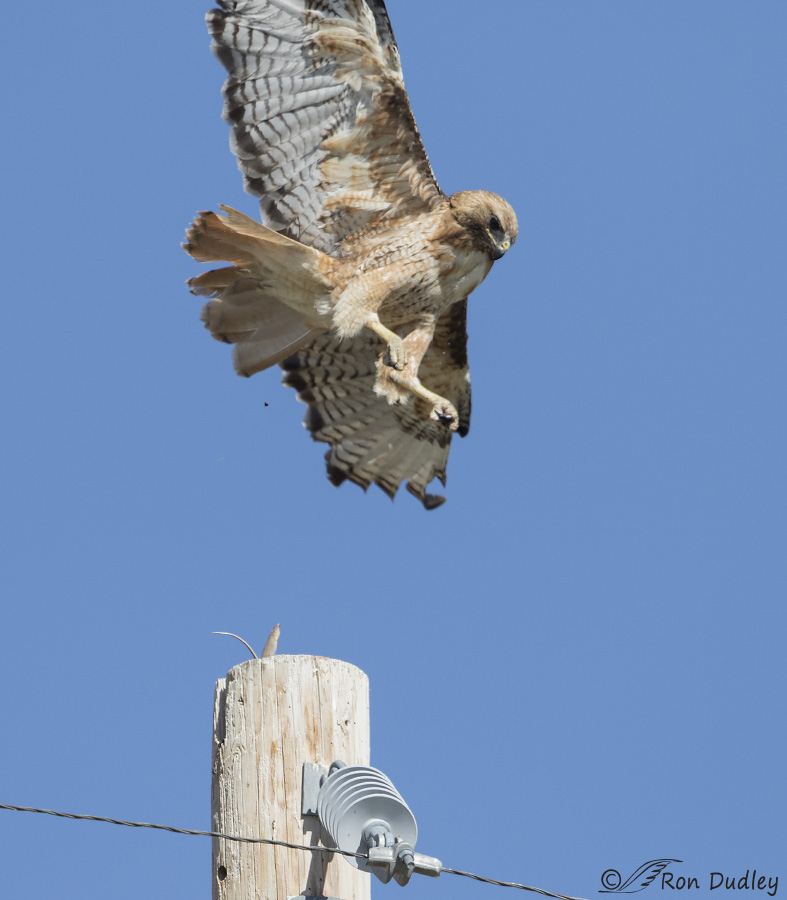
1/3200, f/7.1, ISO 400, Canon 7D Mark II, Canon EF 500mm f/4L IS II USM, not baited, set up or called in
Here the remains of the snake are beginning to fall back to the top of the pole and the hawk is…
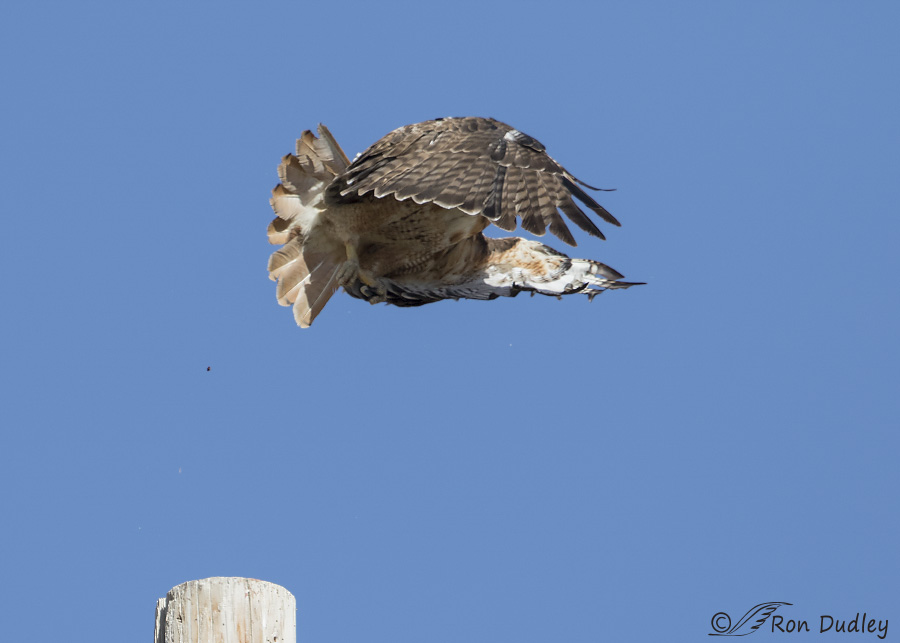
1/3200, f/7.1, ISO 400, Canon 7D Mark II, Canon EF 500mm f/4L IS II USM, not baited, set up or called in
making its getaway. The bird never came back to the “reincarnated” snake while I was there. I can imagine why…
The antics of birds often make me smile but few of them (other than juvenile owls) can make me laugh out loud while I’m watching them through my lens. The reaction of this hawk to the “dead” snake was an exception. I got a huge kick out of it!
And I’ll bet the bird never came back for the rest of the snake.
Ron
Addendum: In response to some of the comments below, some may be interested in this National Geographic video of a decapitated Copperhead biting itself.
I don’t know why some are having problems with the link but you can copy and paste the URL below if you’re interested.
http://voices.nationalgeographic.com/2013/08/16/how-did-a-decapitated-snake-bite-itself/


What an entertaining picture story…thanks Ron!! Great photos as always
Just amazing how you capture some of this stuff!
Thanks, Stephen. How I do it is probably directly proportional to the huge amount of time I spend photographing birds.
Sometimes I think I need to get a life but then I realize I’m living the life I love…
Ack.
You have just reinforced my already titanium distrust of snakes…
An amazing series.
Like I’ve said before, EC, If I lived where you do I wouldn’t trust snakes either.
Later that evening around the campfire, ole Red frightened the fledglings with his outlandish tale of the ATTACK OF THE HEADLESS SNAKE! The other adult hawks could only shake their heads sadly as they were certain he had gone mad and figured he may have molted more than just feathers this year.
If only Red had known there were pictures …..
Another terrific documentary, Ron!
Thank you, Wally. Enjoyed your “story” too.
Terrific story Wally! Gave me a good giggle!
I’m late today, but this was truly fun to read and look at.
Great job at catching this behavior.
I think animals who live for awhile have had near misses with death and injury in their history. An experience like this is comical to us, but to that Red-tail, I would bet it won’t go after another snake unless its really hungry, and even then I think it will look any alternative.
Thanks for sharing.
Dick, it would be interesting to know for sure if this hawk avoids snakes as prey in the future, wouldn’t it?
Dick Harlow, I only have the experience of the one redtail, but she used to take snakes pretty often in Texas until that bull snake in Wyoming tried to kill her back and would probably have succeeded if I hadn’t been there to unwrap it from her neck. After that, she never took another one, and even when I gave her the leftovers of that one during the summer, she refused it. It’s never been like her to refuse food–ever! So there’s truth in what you said!
Thanks Laura, human teenagers could learn a lot by taking heed from the lessons other animals go through.
VERY cool series of images, Ron … read the replies and looks like all are aware about the muscle reflexes in snakes. My grandmother, a farm woman, HATED snakes. She’d whap them dead with whatever she had handy … shovel or tree branch … but she was never convinced they were truly dead and gone until after sunset. Of course we know sunset had nothing to do with it, but it does show that allowing some time to pass is the wisest course of action.
Interesting story about your grandmother, Lois – thanks for providing it.
By the way, this is an open invitation for you to correct my typos (including the singular ‘snack’ just posted) anytime! Typing faster than I think carries its downside, clearly.
Done!
What an amazing series to capture! Wow!
Thank you, Nicole.
Well, that settles it… no more decapitated snakes as snacks for me! This sequence, along with others’ notes, has been most entertaining and instructive. Thanks to you all.
Sorry to have caused you to alter your diet, Alison!
Overall, they really hate it when their food tries to eat/kill them back! That’s just SO annoying and sometimes the food wins! As a predator, you gotta watch out for that
Don’t think I’d like it either, Laura. Food trying to bite me back always ruins my appetite…
I’m with the bird on this one. I’d definitely want nothing to do with food that decided to come after me (especially after I thought I’d killed it). The picture of the snake rising up as the Hawk left the perch still has my adrenaline going. Very effective photography! The National Geographic video did the same thing to me. Hopefully a lot of good things will happen today before I try to go to sleep tonight…
Ha, hope I didn’t ruin your day, Susan!
I’m not sure why some are having troubles with the link. I had a friend try it on her computer and it worked for her. I’ve now provided an alternative way to get to the video, above.
Glitches are a PITA!
Not to worry, Ron. I slept about the same as usual, and the Argentina – Chile soccer game got me worse than the snakes.
Hi Ron
Thanks for sharing your experiences. You have a great eye and observation about what goes around you coupled with a great knowledge of how to get it right on photos.
Thanks for these wonderful posts.
“You have a great eye and observation about what goes around you”
Thanks, Nikhil. But keep in mind that I usually have many other images of any particular behavior that help me to interpret what was going on.
I couldn’t get the link to open, but I’ve had close enough personal experience to get the message…
I just tried it. It worked for me…
Tried it again…on iPad…poked red arrow several times, no luck…maybe it doesn’t like iPads either….might work on something else……the evil one strikes again!
Your ability to capture such amazing examples of bird behavior and to do it with exceptional photography and a dash of humor is wonderful. The only trouble is we expect something even better tomorrow. Thanks, John
I don’t think I’ll be able to top this for a while, John. Thank you.
That poor bird has my empathy…I had a similar encounter with a huge decapitated rattle snake at a sundance years ago…almost had a very unhappy ending for a clueless kid that wanted make a belt buckle put of the head and almost got bitten by the severed head….
We always bury the heads for that reason!
A decapitated venomous snake is NOT a harmless snake. Check out the link to the National Geographic video I’ve provided as an addendum to my text.
Simply amazing behavioral shots Ron! Thanks for sharing!
Charlotte
Thanks very much, Charlotte.
Good one! Yes, the snakes a slow to give up all reflexes when killed! Hawk may never eat another one! Glad you caught this.
Glad you caught this.
Me too, Judy. Even the memories of the incident have provided me with a lot of entertainment!
What a great series ! I usually think of such a great predator as being totally on “top” of its prey–I guess everybody ( and everything ) has more challenges than are usually obvious……thanks for
sharing such an unusual clutch of observations.
I guess hawks don’t have a gag reflex, pulling something out of my throat would have done me in. Great shots and info. Did not know that they would swallow them whole.
“pulling something out of my throat would have done me in”
Yup, I know the feeling…
Wonderful story told well by your photos and narration, Ron. Thanks for the morning treat!
Thanks very much, Den.
By the way, is there a way to edit posts?
I don’t believe so, Den. But if you let me know what you want to edit (using the “contact me” button at the top of my blog) I can do it for you on this end if I’m at the computer at the time. I often wonder if folks want me to fix typos but I’m hesitant to do it without being asked…
PLEASE feel free to fix my typos…ANY TIME…This will help me overcome the evil iPad’s efforts at sabotage!!!
Ok, Patty. I’ll try to remember to do it. Just hope I fix them the way you want them…
Thanks, Ron. The word “wonderfully” is supposed to be “wonderful”. Thanks for volunteering to correct it if you can. I’ll try to be more careful in the future!
Thanks for your wonderful captures and stories!
Done!